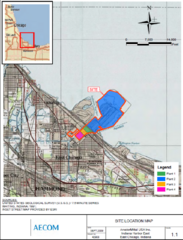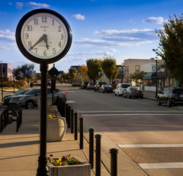|
|
June 13, 2023
Welcome to the Resource Conservation and Recovery Act (RCRA) Corrective Action Edition! Below you will find details and updates about EPA’s Corrective Action Program:
- Progress Toward the 2030 Corrective Action Goals
- Goals 1, 2, and 3 Cleanup Progress and Completion
- Goal 4 Long Term Stewardship
- Goal 5 EPA Adds Facilities to the Corrective Action Tracking List
- Optimization
- Economic Benefits
- Fiscal Year 2022 Results
- 2020 Goal Closeout
|
|
EPA Makes Progress Toward the 2030 Corrective Action Goals
In 2020, EPA held a series of discussions with a wide range of interested parties and partners to gather input to develop a high-level vision, mission, and goals to carry the RCRA Corrective Action program from 2020 to 2030. Discussions included members of the National Environmental Justice Advisory Council; community organizers; federal agencies; local governments through the Revitalizing Communities Workgroup of EPA’s Local Government Advisory Committee; facility owners/operators; tribal partners; and state partners, including the Association of State and Territorial Solid Waste Management Officials (ASTSWMO). The result of these discussions is the new 2030 Vision, Mission, and Goals for the RCRA Corrective Action program, which were announced at the National Corrective Action Conference on September 1, 2020.
The Corrective Action program is focusing on five goals:
-
Through 2030, the RCRA Corrective Action Program will ensure that RCRA cleanups are initiated and completed efficiently and expeditiously. Commitments about what work is planned and what progress is made will be visible to the public. An ambitious universe of cleanups will be identified for completion by 2030.
-
By 2030, the RCRA Corrective Action Program will eliminate or control adverse impacts beyond facility boundaries at RCRA Corrective Action facilities wherever practicable, and the program will focus attention on cleanups that will not meet this target.
-
By 2030, the RCRA Corrective Action Program will ensure or confirm that land within facility boundaries at RCRA Corrective Action facilities will be safe for continued use or reasonably foreseeable new uses wherever practicable, and the program will focus attention on cleanups that will not meet this target.
-
By 2025, the RCRA Corrective Action Program will identify the key elements of effective Long-Term Stewardship for Corrective Action cleanups, and regions and states will have approaches in place to ensure implementation of the key elements.
-
By 2022, program procedures will be in place to regularly adjust the universe of facilities in the cleanup pipeline to reflect current program priorities.
|
|
EPA Focuses on Cleanup Progress and Completion Under Goals 1, 2, and 3
Ensuring that RCRA cleanups are conducted efficiently and completed quickly is EPA’s highest priority to protect surrounding communities. The major aim of these goals is to address cleanup progress and completion. EPA drafted plans for implementation of Goals 1, 2, and 3. The draft plans set ambitious targets for completing cleanup milestones and overall cleanups, plus addresses offsite and onsite cleanup activities. They also focus on transparency, environmental justice, and climate resiliency. In the coming months, EPA will reach out to interested parties for input before finalizing a plan.
|
|
Goal 4: Long-Term Stewardship: EPA Identifies Nine Key Elements
In September 2020, EPA issued a new 2030 Vision, Mission, and Goals for the RCRA Corrective Action Program. The Agency recognized the importance of the long-term effectiveness of cleanups and in Goal 4 committed to steps to achieve that result. Goal 4 provided:
By 2025, the RCRA Corrective Action Program will identify the key elements of effective Long-Term Stewardship for Corrective Action cleanups, and regions and states will have approaches in place to ensure implementation of the key elements.
We formed a Long-Term Stewardship Workgroup to support the implementation of Goal 4. The Workgroup has satisfied the first portion of Goal 4 by identifying nine key elements of effective long-term stewardship in a document which was signed and released on June 27, 2022. These nine elements provide a general framework for regulators establishing and implementing processes to assure effective long-term stewardship at RCRA facilities. Read the memorandum containing these key elements (pdf).
|
|
Goal 5: EPA Adds Facilities to the Corrective Action Tracking List
By 2022, program procedures will be in place to regularly adjust the universe of facilities in the cleanup pipeline to reflect current program priorities.
EPA’s Corrective Action Goal 5 Workgroup completed a year-long pilot project that developed and implemented procedures for adding facilities to the Corrective Action Progress Track. The objective is to include additional facilities where corrective action work is occurring or planned to occur to ensure program oversight and attention. The Workgroup planned and developed the pilot protocol, and regional and state staff across the program developed nominations and worked them through the protocol.
As of September 30, 2022, 59 facilities were added to the Progress Track, bringing the total number of Progress Track facilities to 3,983. In descending order, the number of facilities added in each state were:
- Six each in Colorado and Indiana.
- Five each in Connecticut, Illinois, Michigan, Ohio, Texas, and Wisconsin.
- Four in New Jersey.
- Three in New York.
- Two in Georgia.
- One each in Alabama, Arizona, Kentucky, Massachusetts, North Carolina, South Carolina, Virginia, and Washington.
On March 16, 2023, EPA announced a decision to hold an open season every February for four weeks, so that states and Regions can plan on having a regular timeframe in which they can make additions. For subtractions from the Progress Track list, EPA will conduct outreach to states in spring 2023. Starting April 21 through June 16, states and Regions can nominate subtractions. EPA intends to process the nominations in Summer 2023 and to have them go into effect for fiscal year 2024. EPA keeps the current list of Progress Track facilities in the RCRA Info database and publishes the list on the website Cleanups in My Community.
|
|
|
EPA leveraged the Superfund program’s optimization expertise to advance the progress of “stuck” facilities regulated under RCRA. The Optimization program is site-specific technical assistance where a team of independent experts contracted by EPA conducts a systematic review of a facility of concern that is at any phase of a cleanup process. The objective is to identify opportunities to ensure remedy protectiveness, technical effectiveness, and cost efficiency, and to facilitate progress toward cleanup completion. Since fiscal year 2022, four RCRA optimization reviews were completed and four are under way.
Optimization Example: Cleveland-Cliffs Steel Indiana Harbor East Facility

The Cleveland-Cliffs Steel (formerly ArcelorMittal USA) Indiana Harbor East facility is a 2,400-acre active steel mill located in the city of East Chicago, Indiana. Roughly 1,800 acres of the facility are constructed on an artificial slag fill peninsula extending into Lake Michigan that was continuously expanded from the 1920’s to 1993. Impacts to soil and groundwater at this site are extensive. Contaminants include light nonaqueous phase liquids and dense nonaqueous phase liquids from byproducts from coke production such as coal-tar, naphthalene, fuel oils, and diesel fuel. Fill also impacted groundwater quality, resulting in elevated concentrations of ammonia, cyanide, iron, manganese, and alkalinity, which was observed at some monitoring wells where the pH approaches 13.
The largest barriers to meeting cleanup objectives include:
- The interaction of groundwater to surface water combined with the slag fill itself, which acts as an ongoing source of inorganic groundwater contamination.
- Organic impacts detected at some locations several orders of magnitude above federal or state criteria.
The goal for optimization was to provide third-party review to aid EPA Region 5 Corrective Action Project Managers in discussions with facility contacts to work toward consensus for how to best achieve cleanup goals given site conditions. Optimization created a foundation for prioritization and a more expedient and defensible investigation, with a goal of making remedy decisions that achieve cleanup metrics and measures. The Optimization team supported eight recommendations and two ideas, and EPA Region 5 and the facility accepted almost all of them.
|
|
|
EPA Announced the Economic Benefits of Corrective Action Cleanups

We would also like to announce the significant economic benefits that can stem from RCRA Corrective Action facility cleanups. Our 2021 RCRA Economic Benefits Study provides business-related information for a subset of RCRA Corrective Action sites that are now in either reuse or continued use, subsequent to their cleanup and remediation.
Significant economic benefits are common whenever Corrective Action facilities are successfully cleaned up, creating new opportunities for reuse and redevelopment. In September of 2022, the Agency published the results of the first study of its kind to assess the economic benefits occurring at RCRA facilities after their cleanup. EPA’s analyses of just 79 cleanups revealed that these facilities support 1,028 on-site businesses, which provide economic benefits including:
- $39 billion in annual sales revenue;
- over 82,000 jobs; and
- $7.9 billion in estimated annual employment income.
|

It was further determined that approximately 25% of the facilities in this study are located within communities with potential environmental justice concerns. The cleanups helped to generate:
- 7,900 jobs and more than $522 million in annual income for these communities.
Given that these 79 facilities represent only a small subset of the nearly 4,000 RCRA facilities being cleaned up, the total economic benefits of the RCRA Cleanup Program are even greater nationwide. EPA also developed brief profiles for more than 40 facilities to showcase the economic benefits that can be fostered through RCRA Corrective Action cleanups. A new webpage dedicated to Redevelopment Economics was launched where the public can access these facility profiles and more information about the study.
Also, check out the press release about the study.
|
|
|
EPA Publishes the Cleanup Results from Fiscal Year 2022
The Corrective Action program is driven by its 2030 Vision, Mission, and Goals. This includes meeting annual targets for five important cleanup milestones at facilities:
- Human Exposures Under Control.
- Migration of Contaminated Groundwater Under Control.
- Remedy Construction.
- Construction Complete.
- Ready for Anticipated Use (RAU).
Progress is measured first by protecting public health through controlling human exposure to contamination. The next steps, including controlling the migration of contaminated groundwater and having cleanup technologies constructed and operational, are also important to achieve long-term protection.
In fiscal year 2022, the Corrective Action Program made significant progress on the RCRA Ready for Anticipated Use Long-Term Performance Goal outlined in “EPA’s FY22-FY26 Strategic Plan.” The five-year goal is to make 425 more RCRA corrective action facilities RAU-compliant by September 30, 2026. In 2022, the program surpassed its annual goal of 114 facilities and achieved RAU compliance at 124 facilities.
Nationally, in fiscal year 2022, EPA completed determinations at:
- 41 facilities for Human Exposures Under Control,
- 32 facilities for Groundwater Migration Under Control,
- 55 facilities for Remedy Construction,
- 66 facilities for Cleanup Complete (or Performance Standards Attained), and
- 124 facilities for Ready for Anticipated Use.
The impact of these results is the protection of communities from harmful exposures to contamination from RCRA hazardous waste facilities. As noted in the previous section, the current number of facilities in EPA’s Corrective Action tracking list, called Progress Track, is 3,983. Below you can find information about all the facilities on the Progress Track:
|
Number of Facilities with Migration of Contaminated Groundwater Under Control (CA750)
|
Achieved 3,533 as of end of FY22
|
|
Number of Facilities with Remedy Construction (CA550)
|
Achieved 2,896 as of end of FY22
|
|
Number of Facilities with Ready for Anticipated Use (CA800)
|
Achieved 1,922 as of end of FY22
|
|
Number of Facilities with Performance Standards Attained (CA900/999)
|
Achieved 1,653 as of end of FY22
|
|
|
|
|
Our website provides additional information about the codes in parentheses next to each milestone.
For additional information on Corrective Action Facilities, please visit our Cleanups in My Community webpage. Cleanups in My Community enables you to map and list hazardous waste cleanup locations and drill down to details about those cleanups and other related information.
|
|
|
|
|
In case you missed it, EPA closed out the 2020 goals, demonstrating significant progress by EPA, authorized states, and regulated facilities toward achieving the ultimate goal of completing cleanups that are protective for communities and support economic use and redevelopment.
For additional information on the RCRA Corrective Action Program 2020 Goals Closeout, read our fact sheet (pdf).
|
|
|
The purpose of this newsletter is to provide interested parties with updates about the federal solid and hazardous waste programs, such as information about rulemakings, upcoming webinars, guidance documents, open comment periods, and other related communications.
|
|
|
|
|